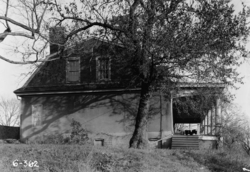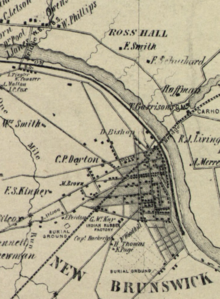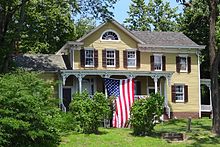| Ross Hall | |
|---|---|
 1936 HABS Photo 1936 HABS Photo | |
 | |
| General information | |
| Status | Destroyed |
| Location | River Road and Ross Hall Boulevard, Piscataway, New Jersey |
| Coordinates | 40°30′39″N 74°26′55″W / 40.51083°N 74.44861°W / 40.51083; -74.44861 |
| Named for | Dr. Alexander Ross |
Ross Hall was a historic colonial farmhouse located on River Road in Piscataway, New Jersey. It was built c. 1739 by Edward Antill and is also known as the Edward Antill House. In 1768, it was purchased by its namesake, Dr. Alexander Ross.
In early July 1778, it was the headquarters for General George Washington when he ordered a feu de joie for the second anniversary of the signing of the Declaration of Independence.
History

In 1688, Edward Antill, Esq. acquired several hundred acres near Raritan Landing. His son, Edward Antill (1701–1770), inherited the 370-acre property and built a house here for his family. On June 10, 1739, he married Anne Morris, daughter of Lewis Morris, Royal Governor of New Jersey. Their first child, Sarah, was born here on August 18, 1740. From these events, the house is dated as either late 1739 or early 1740. The other daughter of Morris married Anthony White, who built the nearby Buccleuch Mansion, across the Raritan River, c. 1739.
Antill extensively farmed his property. He had a large apple orchard of 500 trees. The apples were then used for making cider at his distillery.
The property was sold in 1768 to Dr. Alexander Ross (1723–1775), after whom the house is now known. On February 11, 1775, he married Sarah Farmar. He died shortly after their marriage on November 30, 1775. She later married his assistant, Dr. Charles A. Howard, on August 5, 1778.
The house was next purchased by Miles Smith in 1792. In 1880, George W. Metlar bought the property. He also owned the nearby Ivy Hall, now known as the Cornelius Low House. After 1897, Ross Hall was used as the clubhouse for the New Brunswick Golf Club until 1925.
Metlar sold Ross Hall in the 1920s. Rutgers University owned it in the 1950s. It was damaged by fire in 1954 and destroyed in 1957.
Architecture
Ross Hall was a two-story brick house with a stone foundation and a gambrel roof. It was a blend of Georgian and Dutch colonial farmhouse styles.
Washington headquarters
The Battle of Monmouth was fought on June 28, 1778 in extreme heat, with many deaths due to heat stroke. After the battle, General George Washington and the Continental Army marched north to the Raritan River by New Brunswick for cool, fresh water. The army camped on both sides of the river. Washington made his headquarters at Ross Hall, the home of the widow Ross.
Independence Day parade

From his headquarters, Washington ordered a celebration with a feu de joie for the second anniversary of the signing of the Declaration of Independence:
Tomorrow, the Anniversary of the Declaration of Independence will be celebrated by the firing thirteen Pieces of Cannon and a feu de joie of the whole line; the Army will be formed on the Brunswick side of the Rariton at five o'Clock in the afternoon on the ground pointed out by the Quarter Master General. The Soldiers are to adorn their Hats with Green-Boughs and to make the best appearance possible. The disposition will be given in the orders of tomorrow. Double allowance of rum will be served out.
— George Washington, July 3, 1778
The next day, Washington issued more detailed orders for the celebration:
After the Army is formed, upon a signal by order of the Commander in Chief, thirteen Pieces of Cannon will be discharged, after which a single Cannon which will be a signal for a tuning fire to begin on the right of the Army and be continued to the left with Musquetry and Cannon. At the Conclusion of which, on a signal, three Cheers will be given, "Perpetual and undisturbed Independence to the United States of America."
— George Washington, July 4, 1778
A gentleman at camp reported on this celebration:
My situation being high and at a convenient distance in front, afforded me a complete view of the whole, and presented by far the grandest sight I ever beheld. The running fire of musketry is grand of itself, but the cannon throwing out their columns of smoke, and adding their sounds at proper distances, made it magnificent beyond description.
Legacy

Ross Hall Boulevard in Piscataway is named after the property.
An interior, parlor wall of Ross Hall has been preserved and will be displayed in an educational wing at the nearby Metlar-Bodine House Museum.
On July 4, 1976, a memorial stone was dedicated at the intersection of River Road and Sutphen Road to mark the first Independence Day parade in 1778.
See also
References
- ^ Benedict, William H. (1912). "The First Settlers of New Brunswick: Ross Hall and Its Various Owners". Proceedings of the New Jersey Historical Society. Vol. 7. pp. 9–10.
- Gabrielan, Randall (2001). Images of America: Piscataway Township. p. 17. ISBN 0-7385-0439-4.
- ^ Rutt, Walter E. (1937). "Ross Hall, data pages" (PDF). HABS NJ-362. Historic American Buildings Survey.
{{cite journal}}: Cite journal requires|journal=(help) - Nelson, William (1899). Edward Antill, a New York merchant of the seventeenth century, and his descendants. p. 16.
- Benedict, William H. (1912). "The First Settlers of New Brunswick: Ross Hall and Its Various Owners". Proceedings of the New Jersey Historical Society. Vol. 7. pp. 10–11.
- Gardner, Charles Carroll (1936). Genealogical Dictionary of New Jersey. Genealogical Publishing. pp. 433–35. ISBN 0-8063-1492-3.
- Billopp, Charles Farmar (1907). A History of Thomas and Anne Billopp Farmar, And Some of Their Descendants in America. The Grafton Press. p. 56.
- Wickes, Stephen (1879). "Alexander Ross". History of Medicine in New Jersey, and of its Medical Men. M.R. Dennis & Company. pp. 376–7.
- Wall, John P.; Pickersgill, Harold E., eds. (1921). History of Middlesex County, New Jersey, 1664–1920. Lewis historical publishing Company, Incorporated. p. 262.
- Tucker, Gideon J. (1860). Names of Persons for Whom Marriage Licenses Were Issued by the Secretary of the Province of New York, previous to 1784. Weed, Parsons. p. 192.
- Benedict, William H. (1912). "The First Settlers of New Brunswick: Ross Hall and Its Various Owners". Proceedings of the New Jersey Historical Society. Vol. 7. p. 11.
- "New Brunswick Golf Club". Golftracer's Golf Club Museum.
- "Rutgers University Golf Course". Rutgers University.
- Rutt, Walter E. (1937). "Ross Hall, supplemental" (PDF). HABS NJ-362. Historic American Buildings Survey.
{{cite journal}}: Cite journal requires|journal=(help) - Listokin, Barbara Cyviner (1976). "Antill House". Architectural History of New Brunswick, New Jersey 1681–1900. Rutgers University Art Gallery.
- Meuly, Walter C. (1976). "Revolutionary War 1775–1783". History of Piscataway Township 1666–1976. Piscataway Bicentennial Commission. pp. 104–5.
- Meuly, Walter C. (1976). "Revolutionary War 1775–1783". History of Piscataway Township 1666–1976. Piscataway Bicentennial Commission. p. 105.
- ^ "Ross Hall". The Metlar-Bodine House Museum.
- "Metlar Estate topic of township meeting" (PDF). The Chronicle. March 20, 2004. p. A-2.
- Washington, George (July 3, 1778). General Orders. Library of Congress.
- Washington, George (July 4, 1778). General Orders. Library of Congress.
- Lee, Francis B., ed. (1903). "Extract of a letter from a Gentleman at Camp, dated July 4, 1778". Documents Relating to the Revolutionary History of the State of New Jersey. Vol. 2. New Jersey Historical Society. pp. 280–1.
- "Stone to mark site of parade" (PDF). Piscataway, NJ: pd review. June 24, 1976. p. 3.
External links
- Historic American Buildings Survey (HABS) No. NJ-362, "Dr. Antill House / Ross Hall", 3 photos, 18 measured drawings, 3 data pages, supplemental material
- "Ross Hall". Metlar-Bodine House Museum.
- "Descendants of John and Edward Antill". Mary S. Van Deusen.